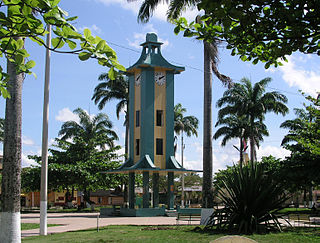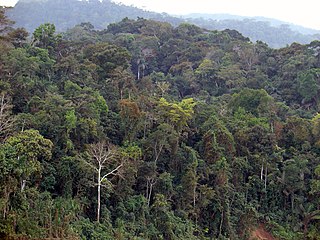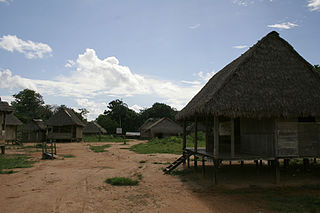
Madre de Dios is a department and region in southeastern Peru, bordering Brazil, Bolivia and the Peruvian departments of Puno, Cusco and Ucayali, in the Amazon Basin. Its capital is the city of Puerto Maldonado. It is also the third largest department in Peru, after Ucayali and Loreto. However, it is also the least densely populated department in Peru, as well as its least populous department. It has one of the lowest poverty rates in Peru.

Puerto Maldonado is a city in southeastern Peru in the Amazon rainforest 55 kilometres (34 mi) west of the Bolivian border, located at the confluence of the Tambopata and Madre de Dios rivers. The latter river joins the Madeira River as a tributary of the Amazon. This city is the capital of the Department of Madre de Dios.

Q'orianka Waira Qoiana Kilcher is an American actress. Her best known film roles are Pocahontas in Terrence Malick's 2005 film The New World, and Kaʻiulani in Princess Kaiulani (2009). In 2020, she starred in a recurring role on the Paramount Network show Yellowstone.

Peru has many languages in use, with its official languages being Spanish, Quechua and Aymara. Spanish has been in the country since it began being taught in the time of José Pardo instead of the country's Native languages, especially the languages in the Andes. In the beginning of the 21st century, it was estimated that in this multilingual country, about 50 very different and popular languages are spoken: which reduces to 44 languages if dialects are considered variants of the same language. The majority of these languages are Indigenous, but the most common language is Spanish, the main language that about 94.4% of the population speaks. Spanish is followed by the country's Indigenous languages, especially all types of Quechua and Aymara (1.7%), who also have co-official status according to Article 48 of the Constitution of Peru, as well as the languages of the Amazon and the Peruvian Sign Language. In urban areas of the country, especially the coastal region, most people are monolingual and only speak Spanish, while in many rural areas of the country, especially in the Amazon, multilingual populations are prevalent.
The Cashibo or Carapache are an indigenous people of Peru. They live near the Aguaytía, San Alejandro, and Súngaro Rivers. The Cashibo have three subgroups, that are the Cashiñon, Kakataibo, and Ruño peoples. They mainly live in five villages.

The Indigenous peoples of Peru, or Native Peruvians, comprise a large number of ethnic groups who inhabit territory in present-day Peru. Indigenous cultures developed here for thousands of years before the arrival of the Spanish in 1532.

Nicolás Suárez Callaú set up a multinational rubber empire in South America at the beginning of the 20th century.

Peruvian Amazonia, informally known locally as the Peruvian jungle or just the jungle, is the area of the Amazon rainforest included within the country of Peru, from east of the Andes to the borders with Ecuador, Colombia, Brazil and Bolivia. This region comprises 60% of the country and is marked by a large degree of biodiversity. Peru has the second-largest portion of the Amazon rainforest after the Brazilian Amazon.

The Amazon rubber cycle or boom was an important part of the economic and social history of Brazil and Amazonian regions of neighboring countries, being related to the extraction and commercialization of rubber. Centered in the Amazon Basin, the boom resulted in a large expansion of colonization in the area, attracting immigrant workers, generating wealth, causing cultural and social transformations, and disrupting local indigenous societies.
The Mashco-Piro or Mascho Piro, also known as the Cujareño people and Nomole, are an indigenous tribe of nomadic hunter-gatherers who inhabit the remote regions of the Amazon rainforest. They live in Manú National Park in the Madre de Dios Region in Peru. They have in the past actively avoided contact with non-native peoples.

The Tambopata River is a river in southeastern Peru and northwestern Bolivia. Most of the Tambopata is in the Madre de Dios and Puno regions in Peru, but the upper parts of the river forms the border between Peru and Bolivia, and its origin is in La Paz department in Bolivia. The Tambopata is a tributary of the Madre de Dios River, into which it merges at the city of Puerto Maldonado. The river flows through the Tambopata National Reserve.

Harakmbut or Harakmbet is the native language of the Harakmbut people of Peru. It is spoken along the Madre de Dios and Colorado Rivers, in the pre-contact country of the people. There are two dialects that remain vital: Amarakaeri (Arakmbut) and Watipaeri (Huachipaeri), which are reported to be mutually intelligible. The relationship between speakers of the two dialects is hostile.

The Amarakaeri Communal Reserve is a protected area in Peru located in the Madre de Dios Region, Manú Province. It protects parts of the Southwest Amazon moist forests and Peruvian Yungas ecoregions.

Carlos Fermín Fitzcarrald López was a Peruvian rubber baron. He was born in San Luis, Ancash, in a province which was later named after him. In the early 1890s, he discovered the Isthmus of Fitzcarrald, which was a portage route that allowed transportation from the Ucayali River into the Madre de Dios River basin. Fitzcarrald became known as the "King of Caucho" due to his success during the rubber boom. His enterprise exploited and enslaved Asháninka, Mashco-Piro, Harákmbut, Shipibo-Conibo and various other native groups, which were then dedicated to the extraction of rubber. Fitzcarrald drowned in a river accident on the Urubamba River in 1897, along with his Bolivian business partner Antonio de Vaca Díez.

The Ese Ejja are an indigenous people of Bolivia and Peru, in the southwestern Amazon basin. 1,687 Ese Ejja live in Bolivia, in the Pando and Beni Departments, in the foothills along the Beni and the Madre de Dios Rivers. In Peru, they live along the Tambopata and Heath Rivers, near Puerto Maldonado.
The Yine are an indigenous people in Peru. In the Cusco, Loreto, and Ucayali Departments, they live along the Urubamba River. They live along the Madre de Dios River in the Madre de Dios Department.

The Las Piedras River is a major tributary of the Madre de Dios River in the southeast Peruvian Amazon.

The Fitzcarrald Isthmus is an 11 km long land bridge that connected important rubber trade routes of the Urubamba River and the Madre de Dios River in Peru.

Carlos Scharff was a Peruvian rubber baron of German descent who was active along the Upper Purus and Las Piedras rivers during the Amazon rubber boom in Peru. He also served for many years during his youth as an agent for the Belgian consulate in Brazil.
















